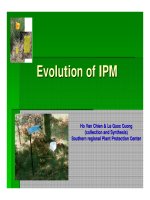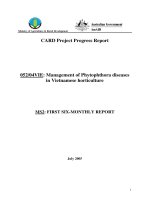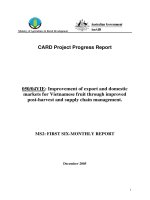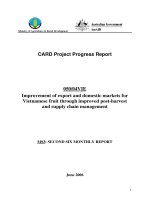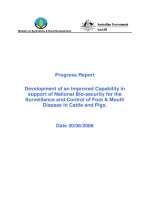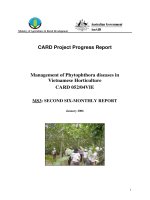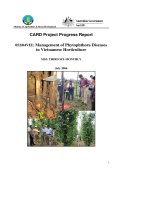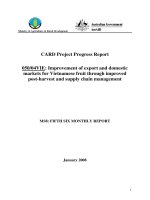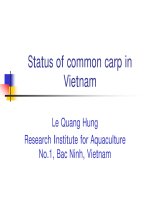Báo cáo nghiên cứu khoa học " GENOTYPING OF COMMON CARP STRAINS " pot
Bạn đang xem bản rút gọn của tài liệu. Xem và tải ngay bản đầy đủ của tài liệu tại đây (296.64 KB, 23 trang )
1
GENOTYPING OF COMMON CARP STRAINS
BINH, T.T., TAN, N.T., HUNG, L.Q., ¸AUSTIN C.
I. SSCP RESULTS
1. Control region sequences and SSCP variation
Sequences for a 745 bp fragment of the mtDNA CR were obtained from 111 fish
representing 41 populations or strains. A total of 19 haplotypes with 78 variable and
30 phylogenetically informative sites were identified. The nucleotide composition
was A + T rich (A= 31%; T= 32%), and variation consisted predominantly of
transitions (Ti : Tv = 2.56). All sequences have been deposited in GenBank (AC:
AY597942-AY597976; DQ354144-DQ354149).
Vietnamese carp populations have high haplotype diversity (mean = 0.92±0.02), but
low nucleotide diversity (mean = 0.01±0.00). The most divergent Vietnamese
haplotypes differed by only 9 base pairs. Diversity and relationships among
haplotypes are depicted in Fig. 4.2 together with the 14 corresponding SSCP
phenotypes determined from the shorter (230 bp) fragment. From this figure it can be
seen that the SSCP technique was successful in resolving a significant proportion of
the nucleotide variation detected in sequencing the longer CR fragment. It is
noteworthy that four of these haplotypes allow the discrimination of Vietnamese
white (haplotype C), Hungarian (haplotype A) and Indonesian yellow (haplotypes B
& D) carp strains from RIA 1. In addition, common carp samples from China
(haplotypes I & R) and Indonesian (haplotypes B, D &J) and Koi carp (haplotype L)
were all distinguishable from Vietnamese carp.
The summary of relationships among CR haplotypes (Fig. 4.2) shows that, apart from
two of the Chinese strains, which share the same haplotype, and are quite divergent
from the other carp samples, there are a large number of haplotypes that are closely
related to each other. Minor exceptions are the Hungarian carp haplotype (A) and a
haplotype found in Bak Kan and Dak Lak (haplotype E), the Bang Giang River
(haplotype F) and the Lo River (haplotype G) and Koi carp (haplotype L).
A total of 968 individuals from both wild and hatchery populations were scored for
SSCP variation. In addition to the non-Vietnamese strains that had seven
distinguishable SSCP phenotypes, five SSCP haplotypes were distinguishable among
Vietnamese common carp samples. Comparison with the nucleotide sequences
revealed that these SSCP haplotype differ by 3-8 bp. Haplotype frequencies and
diversity estimates are summarized in Table 4.2 for 20 common carp populations.
Three haplotypes, Hungarian (A), Indonesian (B) and Vietnamese (C), predominated
in common carp samples and five (D, E, F, G and H) were relatively rare or occurred
only at low frequencies. Intra-population diversity varies widely among the
populations ranging from populations with a single haplotype (h =0) to six
haplotypes (h = 0.55). The experimental strains from RIA1 have the lowest diversity
(h= 0-0.28), the hatchery stocks with the exception of Thai Nguyen, have high
diversity (h = 0.49-0.64) and the wild stocks have an intermediate level of diversity
(h = 0.26-0.41) (Table 4.2).
2
The three experimental strains from RIA1 are also highly differentiated from each
other. The Hungarian scale strain is fixed for haplotype A, the Indonesian yellow
strain is dominated by haplotype B (84%), while the Vietnamese white strain in
dominated by haplotype C (94%). All three of these haplotypes are found in almost
all hatchery and wild carp populations, however in the Vietnamese white strain
haplotype C dominate (55%) followed by the predominate Indonesian haplotype B at
25% and the Hungarian haplotype A at 12%.
The six wild common carp populations (RER, LOR, LAR, SOR, DAL, and BGR)
have generally similar haplotype profiles and like the Vietnamese experimental strain,
haplotype C predominates. Six of the hatchery stocks have haplotype profiles largely
similar to the wild populations (haplotype C = 0.52-0.94). The five other hatchery
samples, in contrast, have haplotype profiles dominated by the Indonesian haplotype
B (0.50-0.84), although it is noteworthy that they also all possess the Vietnamese
haplotype C, albeit at a lower frequency (0.04-0.39). Interestingly, almost all
hatchery and wild samples have the Hungarian haplotype (A), although it mostly
occurs at a relatively low frequency (0.02-0.20).
2.
Genetic differentiation and relationships among populations
Pairwise Fst analyses indicates significant genetic heterogeneity among populations
with the majority of pairwise comparisons yielding signification differences (Table
4.3). All three experimental strains are highly differentiated from each other (Fst =
0.78-0.94). The Hungarian strain was the most divergent and is significantly
differentiated from all other common carp populations (Fst = 0.58-0.94). The
Indonesian strain is also highly distinct, and is significantly different from all other
samples except for four hatchery populations. The Vietnamese strain is also
divergent from most other samples with the exception of four of the wild populations.
The extent of the difference between the three experimental lines and their
relationships to the hatchery and wild samples are clearly evident from the UPGMA
dendrogram (Fig. 4.3) where it can be seen that the wild samples cluster with the
Vietnamese white experimental line (group C1 in Fig. 4.3) and the hatchery
populations cluster either with the Indonesian strain (group B in Fig. 4.3) or form a
cluster (group C2 in Fig. 4.3) linked to the wild populations, which together form the
Vietnamese cluster (group C in Fig. 4.3).
Multidimensional scaling (Fig. 4.4) also emphasises the clear differentiation of the
three experimental strains and largely re-inforces the findings of the preceding
UPGMA analysis. From Figure. 4.4, it is also clear that hatchery and wild stocks are
well differentiated from the Hungarian experimental line and that all hatchery stocks
are genetically intermediate between the Vietnamese white strain (or closely related
populations) and the Indonesian strain. In contrast to the relationship depicted by the
UPGMA dendrogram (Fig. 4.3), it is apparent that the hatchery stocks did not so
much fall into two distinct groups associated with either the Vietnamese or
Indonesian strains, but represented more of a continuum between these two stocks.
For example population Tuyen Quang (TUQ) placed in the Vietnamese cluster and
populations Can Tho (CAT) and Sai Gon (SAG), placed in the Indonesian cluster in
3
Fig. 4.3 are actually quite similar genetically, and fall into an intermediate
position on MDS axis 1 between the Vietnamese and Indonesian strains.
The AMOVA analysis indicates that the genetic variation is partitioned very
differently within and between populations for the experimental strains, hatchery
stocks and wild populations (Table 4.4). For the experimental group, the variation is
predominately between populations (86.30%) with very low levels of within
populations (13.70%). This is in contrast to the wild populations for which the
pattern of variation is reversed with 96.2% of the variation within populations and
only 3.8% between populations. The hatchery populations have intermediate values,
with within population variation significantly enhanced (80.47%) compared with the
experiment lines and the between population variation substantially elevated
compared with the wild populations (19.53%).
1
Research Institute for Aquaculture No 1;
2
Origin of sample not provided; E:
Experimental group; H: Hatchery group; W: Wild group.
4
Population Code Location
Type
Sequencing SSCPs
Hungarian scale-RIA1
1
HUS Tu Son, Bac Ninh, Vietnam
E
450
Indonesian yellow-RIA1 IDY Tu Son, Bac Ninh, Vietnam
E
650
Vietnamese white-RIA1 VNW Tu Son, Bac Ninh, Vietnam
E
450
Vinh Phuc VIP Me Linh, Vinh Phuc, Vietnam
H
450
Thai Nguyen THN Cu Van, Thai Nguyen, Vietnam
H
350
Son La
H
Bac Kan
Tuyen Quang
Yen Bai
Hoa Binh
Ha Tinh
Can Tho
Sai Gon
Thac Ba Res
Bang Giang R
Lo River
Red River
Lam River
Son River
Dak Lak
Xingguonens
Wananensis
Wuyuanensis
Color
Red Koi
Wild Amur
Majadanu
Rajadanu
Widan
GenBank
Goldfish
Population size (n)
Table 4.1. Location, code and number of samples sequenced and analysed by the
SSCP technique.
SOL Son La town, Son La, Vietnam 450
BAK Bach Thong, Bac Kan, Vietnam
H
650
TUQ Hoang Khai, Tuyen Quang, Vietnam
H
450
YEB Van Chan, Yen Bai, Vietnam
H
350
HOB Hoa Binh town, Hoa Binh, Vietnam
H
650
HAT Duc Long, Ha Tinh, Vietnam
H
450
CAT Cai Rang, Can Tho, Vietnam
H
436
SAG Binh Chanh, Sai Gon, Vietnam
H
435
ervoir TBR Yen Binh, Yen Bai, Vietnam
H
350
iver BGR Cao Bang town, Cao Bang, Vietnam
W
650
LOR Yen Son, Tuyen Quang, Vietnam
W
450
RER Van Giang, Hai Hung, Vietnam
W
450
LAR Nam Dan, Nghe An, Vietnam
W
350
SOR Bo Trach, Quang Binh, Vietnam
W
447
DAL Ea Kao, Dak Lak, Vietnam
W
450
is XIG Jaing xi China 3 5
WAN Jaing xi China 3 5
WUY Jaing xi China 3 5
COL Jaing xi China 3 5
REK Komaki Japan 3 21
WAR Karnataka, India 3 5
MAJ Sukamandi, Indonesia 3 5
RAJ Sukamandi, Indonesia 3 5
WID Sukamandi, Indonesia 3 5
GBK
Taiwan
2
1
GOF Unknown 1
5
Table 4.2
. Number of haplotypes and haplotype diversity in each common carp population. Population code given in Table 4.1
H I VN VP TN SL BK TQ YB HB HT CT SG TBR BGR LR RR LA SR DL
A 1.00 0.12 0.08 0.16 0.08 0.24 0.06 0.08 0.20 0.20 0.02 0.04 0.08 0.02 0.12
B 0.84 0.04 0.66 0.80 0.62 0.08 0.20 0.22 0.22 0.04 0.50 0.54 0.02 0.02 0.04 0.04 0.06 0.14 0.25
C 0.04 0.94 0.14 0.10 0.18 0.66 0.52 0.62 0.68 0.68 0.39 0.31 0.74 0.78 0.84 0.86 0.90 0.76 0.82 0.55
D 0.12 0.02 0.08 0.04 0.02 0.02 0.04 0.02 0.08 0.11 0.14 0.02 0.02 0.02 0.02 0.04
E 0.02 0.12 0.06 0.13 0.04 0.02
F 0.04 0.02 0.16 0.01
G 0.04 0.06 0.01
H 0.19 0.01
No of haplotypes 133 44465544334 5544333.85
Haplotype diversity 0.00 0.28 0.12 0.53 0.35 0.57 0.55 0.64 0.57 0.49 0.50 0.60 0.60 0.42 0.37 0.29 0.26 0.19 0.41 0.31 0.40
Wild
MeanHaplotypes
Experimental Hatchery
6
Table 4.3. Pair-wise estimate of variance of haplotype frequencies (Fst) among of samples. Population codes given in Table 4.1.
HUS IDY VNW VIP THN SOL BAK TUQ YEB HOB HAT CAT SAG TBR BGR LOR RER LAR SOR DAL
HUS
IDY 0.86*
VNW 0.94* 0.78*
VIP 0.70* 0.05 0.61*
THN 0.81* 0.02 0.73* 0.01
SOL 0.66* 0.09* 0.58* 0.01 0.03
BAK 0.70* 0.54* 0.12* 0.36* 0.48* 0.32*
TUQ 0.58* 0.43* 0.24* 0.23* 0.35* 0.18* 0.04
YEB 0.70* 0.46* 0.16* 0.27* 0.39* 0.23* 0.00 0.02
HOB 0.73* 0.51* 0.13* 0.31* 0.44* 0.27* 0.01 0.02 0.01
HAT 0.69* 0.58* 0.14* 0.39* 0.52* 0.35* 0.01 0.03 0.04 0.03
CAT 0.74* 0.21 0.44* 0.06 0.16* 0.05 0.18* 0.10 0.09 0.12* 0.22*
SAG 0.74* 0.15 0.50* 0.03 0.11 0.03 0.23* 0.14* 0.14 0.18* 0.27* 0.01
TBR 0.74* 0.63* 0.12* 0.45* 0.57* 0.40* 0.02 0.06 0.06 0.04 0.01 0.28* 0.33*
BGR 0.81* 0.65* 0.08* 0.48* 0.60* 0.44* 0.03 0.13* 0.08 0.07 0.06 0.30* 0.35* 0.05*
LOR 0.86* 0.71* 0.01 0.53* 0.65* 0.49* 0.05 0.15* 0.09* 0.07 0.06 0.34* 0.41* 0.04 0.04
RER 0.86* 0.71* 0.01 0.53* 0.65* 0.49* 0.05 0.14* 0.09 0.06 0.04 0.35* 0.41* 0.03 0.04 0.01
LAR 0.90* 0.74* 0.01 0.56* 0.69* 0.53* 0.08* 0.19* 0.11* 0.09 0.09* 0.38* 0.44* 0.08* 0.05 0.01 0.01
SOR 0.81* 0.65* 0.09* 0.47* 0.59* 0.44* 0.02 0.13* 0.07* 0.07* 0.07 0.29* 0.35* 0.06* 0.05 0.05 0.05* 0.07
DAL 0.84* 0.65* 0.04* 0.47* 0.59* 0.43* 0.03 0.12* 0.04 0.02 0.07* 0.26* 0.33* 0.06 0.04 0.01 0.01 0.01 0.04
* P<0.05 following sequential Bonferroni correction.
7
Table 4.4. AMOVA results for three groups (experimental, hatchery, wild) of 20
common carp populations base on SSCP data. (Intra = intrapopulation, Inter =
interpopulation, values are %)
Group Intra Inter
P
-value
F
st
Experiment 13.70 86.30 0.01 0.86
Hatchery 80.47 19.53 0.01 0.20
Wild 96.16 3.84 0.04 0.04
All 63.02 36.98 0.01 0.37
8
Figure. 4.1. Collection localities for Cyprinus carpio L. samples in Vietnam
9
Goldfish
0.005 substitutions/site
Xingguonensis
GenBank
Koi
Color
Wananensis
Wuyunanensis
Majadanu 1
Wild Amur
Rajadanu
Widan
Majadanu 2
Hungarian
Son La 2
Vinh Phuc 2
Bang Giang River 2
Dak Lak
Bac Kan 2
Lo River 1
Bac Kan 1
Son La 1
Vinh Phuc 1
Indonesian Yellow 1
Thac Ba Reservoir 2
Hoa Binh 1
Tuyen Quang 1
Bang Giang River 1
Tuyen Quang 2
Lo River 2
Vietnamese White
Thac Ba Reservoir 1
Thai Nguyen
Son River 1
Sai Gon
Red River
Lam River
Ha Tinh
Can Tho
Yen Bai 2
Yen Bai 1
Hoa Binh 2
Indonesian Yellow 2
Son River 2
100
56
94
100
76
97
56
SSCP haplotype
C
G
B
C
D
H
F
C
A
E
I
J
L
K
BDAEFGHC BDAEFGHC
(a)
(b)
Figure. 4.2. Silver stained polyacrylamide gel showing the eight SSCP variants
detected in common carp populations in Vietnam (a). Neighbour-joining tree
reconstruction derived from CR sequences, using HKY+I+G model of evolution.
Bootstrap values are based on 1,000 replicates. Bootstrap value is given for nodes
with at least 50% or more support (b).
10
Vietnamese white (VN)-RIA 1
Lam River (LAR)
Lo River
(LOR)
Red River (RER)
Da k La k ( DAL)
Bang Giang River (BGR)
Son River (SOR)
Yen Bai (YEB)
Hoa Binh (HOB)
Bac Kan (BK)
Tuyen Quang (TUQ)
Thac Ba Reservoir (TBR)
Ha Tinh (HAT)
Indonesian yellow (IDY)-RIA 1
Thai Nguyen (THN)
Vinh Phuc (VIP)
Son La (SOL)
Can Tho (CAT)
Sa i Go n ( SAG)
Hungarian (HUS)-RIA 1
Wi ld
C1
C2
C
B
A
Experimenta
l
Ha tc h e ry
Experimenta
l
Ha tc h e ry
Experimenta
l
Figure. 4.3
. Relationships among common carp from wild and hatchery population
in Vietnam using the unbiased genetic distance of Roger (1972) and UPGMA joining
method. A, B, and C are SSCP haplotypes which predominate in each cluster.
11
HUS
IDY
VNW
VIP
THN
SOL
BAK
TUQ
YEB
HOB
TBR
BGR
LOR
RER
LAR
HAT
SAR
DAL
CAT
SAG
-0.6
-0.4
-0.2
0
0.2
0.4
0.6
0.8
1
1.2
1.4
1.6
-0.8 -0.6 -0.4 -0.2 0 0.2 0.4 0.6 0.8 1 1.2 1.4 1.6
Dimension 1
Dimension 2
Experimental population
Wild population
Hatchery population
Figure. 4.4. MDS plot of pairwise Fst value among hatchery and wild populations of
common carp in Vietnam. Population codes are given in Table 4.1.
12
II. MICROSATELLITE RESULTS
1. Within population variation
All four loci were polymorphic and were variable in all populations (Table 5.3). A
total of 72 different alleles ranging in size from 100 to 262 bp were found over the
four loci. The number of alleles ranged from 10 at MFW9 to 23 at MFW1 and with
from three to 15 alleles per population per locus.
Within populations, the lowest mean number of alleles per locus (4.25) was observed
in the Indonesian yellow common carp experimental line (IDY), while the highest
mean number of alleles per locus (11.00) was found in the wild Red River population
(RER). Average observed heterozygosity ranged from 0.40 in the Indonesian yellow
carp experimental line to 0.83 in the Red River population. Average allelic diversity
was the lowest in the experimental lines (5.50-8.25), highest in the wild populations
(8.75-10.00) and generally intermediate in the hatchery populations (6.50-9.50).
Average observed heterozygosity showed a similar trend with the experimental lines
having the lowest average observed heterozygosity (0.40-0.59), the wild populations
the highest (0.77-0.83) and the hatchery populations again with generally
intermediate value (0.51-0.81) (Table 5.3).
Of the 80 HWE test, 37 were significant and all but five of the tests were associated
with heterozygote deficiencies. A much greater proportion of significant HWE tests
occurred within the experimental lines (8 of 12) and the hatchery stocks (27 of 44)
compared with the wild population (7 of 24). Based on average Fis values it can be
seen that the pattern of heterozygotes deficiencies was most pronounced in the
experimental lines (0.19-0.26). Heterozygote deficiencies were also apparent in the
hatchery populations with the exception of Thac Ba Reservoir (TBR) but not to the
same degree (Fis = 0.05-0.22). The wild population showed minimal heterozygote
deficits (-0.11-0.05).
The proportion of private alleles showed the converse pattern to the Fst values.
Across the four loci only three private alleles occurred within the three experimental
lines and only 12 within the 11 hatchery populations, which compares with 19
private alleles in the six wild populations (Table 5.4).
2.
Genetic differentiation and relationships among populations
Pairwise Fst analyses indicates significant genetic heterogeneity among populations
with the majority of pairwise comparisons yielding signification differences (Table
5.5). The three experimental strains were well differentiated from each other (Fst =
0.16-0.34). The Hungarian strain was the most divergent (Fst= 0.10-0.34) followed
by the Indonesian strain (Fst= 0.05-0.21). While the Vietnamese experimental strain
was significantly different from most of the other samples Fst value were generally
lower (Table 5.5).
Allelic frequencies at the four loci for the three experimental lines are depicted in Fig.
5.2. The differences between the three experimental lines are largely a matter of
degree and none of the loci provide a profile that is diagnostic for any of the three
experimental lines. Nevertheless, some loci are more effective than other in
distinguishing particular strains. For example, the Hungarian strain has almost
13
exclusively small sized alleles at locus MFW7 compared to the Indonesian and
Vietnamese strain. The distinction between the three strains is generally a
combination of allelic difference that accumulates across the loci. This is most
marked in the Indonesian strain which has one or two alleles at high or moderately
high frequencies at MFW1, MFW6 and MFW7 that are absent or at low frequencies
in the other two experimental lines. The Vietnamese strain is distinguished
substantially by a large number of private alleles occurring at low frequencies that
are spread across all loci. The ability of allelic variation at these loci as a group to
distinguish between three strains is demonstrated by assignment test using just these
strains. This test resulted in only 15 (10%) of the 150 individuals being misclassified.
Levels of differentiation were limited among the wild population and similarly with
that hatchery samples except for samples BAK and TBR. The UPGMA dendrogram
emphasises the distinctiveness of the Hungarian sample which forms the most basal
branch (A) (Fig. 5.3). The remaining samples form two distinct clusters (B) and (C).
One (C) contains the Indonesian sample, which is the most distinct of all samples in
this cluster and all but two of the hatchery samples. The other cluster (B) contains the
Vietnamese experimental line, all the wild populations and two of the hatchery
samples (BAK and TBR). The MDS analysis (Fig. 5.4) reflects these same
relationships and emphasizes the distinctiveness of the three experimental lines and
the distinctiveness of the Hungarian strain. In addition this analysis indicates that the
hatchery samples (excluding BAK and TBR), while generally closest to the
Indonesian experimental line fall into an intermediate position between the
Vietnamese and Hungarian samples. Some of these samples are almost equidistant
between the experimental lines. For example HAT is almost exactly halfway
between the Vietnamese and Indonesian experimental lines and Tuyen Quang (TUQ)
is almost equidistant between the Hungarian and Indonesian samples (Fig. 5.3).
The results of the assignment test using all 20 populations confirms and extends the
population genetic (Fst) and phylogenetic genetic distance-based analyses (Table
5.6). Overall there is a relatively high proportion of misclassifications, reflecting the
generally limited divergence among populations. However the pattern of
misclassification differs among the three groups. The highest proportion of correct
classification is among the experimental strains and the wild populations, although
the Vietnamese white carp (VNW) experimental strains and wild population
exchange a relatively higher proportion of misclassifications. The hatchery
populations as a group suffer the highest proportion of misclassifications. With the
exception of samples TBR and BAK, there is a consistent pattern of misclassification,
involving the other hatchery stocks and the Indonesian and Hungarian experimental
lines. There was also a small but consistent amount of misclassification between the
hatchery samples and the Vietnamese experimental lines and wild samples. The
samples TBR and BAK differ from the other hatchery samples as the extent of
misclassification between the Indonesian or Hungarian lines and hatchery stocks on
the one hand and the Vietnamese experimental line and wild stock on the other, are
about equal.
The AMOVA analysis is consistent with the previous analysis and highlights the
differences between the partioning of genetic variation between the experimental
lines and wild population (Table 5.7). For the experimental group the proportion of
inter-population variation (23.80%) is much greater than for the wild populations
14
(1.03%). The distribution of intra- and inter-population variation in the hatchery
samples is intermediate between the experimental and wild populations but more
similar to the latter group. From Table 5.7 it can be seen that the hatchery samples
are also intermediate with respect to allelic richness and observed heterzygosity.
15
Locus Primer Size (bp)
Annealing temp. (T
o
)
MgCl
2
MFW1
F13: GTC CAG ATC GTC ATC AGG AG
184 -230 62 1.5
R: GTT TGA GGT GTA CAC TGA GTC AGG C
MFW6
F13: ACC TGA TCA ATC CCT GGC TC
130 - 219 62 1.5
R: GTT TGG GAC TTT TAA ATC ACG TTG
MFW7
F13: TAC TTT GCT CAG GAC GGA TGC
192 -262 62 1.5
R: GTT TAT CAC CTG CAC ATC GCC ACT C
MFW9
F13: GATCTGCAAGCATATCTGTCG
92 - 144 60 1.5
R: GTTTATCTGAACCTGCAGCTCCTC
Table 5.5. Characteristics of Cyprinus carpio microsatellite loci tested
16
Table 5.6. Genetic variability of four microsatellite loci in 20 populations for common carp in Vietnam. Population codes given in Table 4.1.
Locus Parameter HUS IDY VNW VIP THN SOL BAK TUQ YEB HOB HAT CAT SAG TBR BGR LOR RER LAR SOR DAL Average
cross
population
MFW1 N 50 50 50 50 50 50 50 50 50 50 50 36 34 50 50 50 50 50 50 50 48.50
A 6491010111371211111171211151211121410.45
He 0.62 0.57 0.82 0.83 0.85 0.88 0.84 0.80 0.81 0.81 0.83 0.79 0.79 0.85 0.88 0.87 0.90 0.87 0.80 0.86 0.81
Ho 0.48 0.24 0.46 0.48 0.44 0.46 0.62 0.44 0.60 0.48 0.58 0.56 0.47 0.88 0.76 0.86 0.72 0.80 0.68 0.78 0.59
P
H
W
******************n.s.n.s.n.s.*n.s.**
Fis 0.21 0.53 0.41 0.41 0.47 0.46 0.24 0.44 0.24 0.39 0.27 0.27 0.35 -0.04 0.12 0 0.18 0.06 0.02 0.08 0.26
MFW6 N 50 50 50 50 50 50 50 50 50 50 50 36 34 50 50 50 50 50 50 50 48.50
A 4710988106118957111411111011109.00
He 0.74 0.69 0.86 0.69 0.73 0.62 0.86 0.74 0.77 0.72 0.78 0.59 0.74 0.85 0.85 0.82 0.82 0.85 0.81 0.83 0.77
Ho 0.60 0.68 0.56 0.78 0.80 0.62 0.68 0.64 0.84 0.64 0.72 0.64 0.85 0.68 0.84 0.83 0.86 0.68 0.70 0.74 0.72
P
H
W
* n.s. ** ** * n.s. * * * ** n.s. * n.s. * n.s. n.s. n.s. * * n.s.
Fis 0.17 0 0.33 -0.14 -0.11 -0.01 0.19 0.12 -0.09 0.96 0.06 -0.1 -0.18 0.18 0.1 -0.01 0.05 0.18 0.28 0.09 0.10
MFW7 N 50 50 50 50 50 50 50 50 50 50 50 36 34 50 50 50 50 50 50 50 48.50
A 9 3 109 1215106 111111108 101112159 109 10.05
He 0.70 0.27 0.84 0.68 0.59 0.72 0.82 0.51 0.78 0.49 0.64 0.50 0.34 0.72 0.84 0.86 0.86 0.79 0.79 0.84 0.68
Ho 0.52 0.22 0.60 0.56 0.34 0.32 0.44 0.28 0.44 0.22 0.32 0.42 0.21 0.88 0.82 0.74 0.82 0.84 0.82 0.80 0.53
P
H
W
**n.s.*********n.s.n.s.n.s.n.s.*n.s.n.s.n.s.n.s.
Fis 0.24 0.09 0.28 0.16 0.42 0.53 0.46 0.42 0.41 0.53 0.4 0.13 0.34 -0.22 0.01 0.12 0.06 -0.07 -0.04 0.03 0.22
MFW9 N 50 50 50 50 50 50 50 50 50 50 50 36 34 50 50 50 50 50 50 50 48.50
A 334464444455454565544.40
He 0.62 0.58 0.74 0.54 0.64 0.62 0.75 0.61 0.63 0.69 0.69 0.63 0.55 0.78 0.73 0.75 0.75 0.83 0.86 0.74 0.69
Ho 0.42 0.46 0.72 0.58 0.60 0.66 0.74 0.76 0.68 0.74 0.94 0.58 0.53 0.78 0.76 0.78 0.88 0.92 0.98 0.80 0.72
P
H
W
* n.s. n.s. n.s. * n.s. n.s. n.s. n.s. n.s. n.s. n.s. n.s. n.s. n.s. * n.s. n.s. n.s. n.s.
Fis 0.3 0.13 0 -0.11 0.04 -0.78 -0.01 -0.25 -0.09 -0.07 -0.37 0.06 0.02 -0.01 -0.05 -0.56 -0.17 -0.61 -0.48 -0.09 -0.16
Mean A 5.50 4.25 8.25 8.00 9.00 9.50 9.25 5.75 9.50 8.50 9.00 7.75 6.50 9.50 10.00 10.75 11.00 8.75 9.50 9.25
(all loci) He 0.67 0.53 0.81 0.68 0.70 0.71 0.82 0.67 0.75 0.68 0.73 0.63 0.60 0.80 0.82 0.82 0.83 0.83 0.81 0.82
Ho 0.51 0.40 0.59 0.60 0.55 0.52 0.62 0.53 0.64 0.52 0.64 0.55 0.51 0.81 0.80 0.80 0.82 0.81 0.80 0.78
P
H
W
***************n.s.n.s.n.s.n.s.n.s.n.s.n.s.*
Fis 0.23 0.19 0.26 0.08 0.21 0.05 0.22 0.18 0.12 0.45 0.09 0.09 0.13 -0.02 0.05 -0.11 0.03 -0.11 -0.06 0.03
(N = sample size; A= total number of alleles; He = expected heterozygosity; Ho = observed heterozygosity; P
HW = Hardy-Weinberg probability
test: * P <0.05; ** P <0.01; Fis = fixation indices; n.s. = non-significant)
17
Population Total
MFW1 MFW6 MFW7 MFW9
HUS
11
IDY
22
VN
0
VIP
11
TN
123
SOL
123
BAK
22
TUQ
0
YEB
123
HOB
0
HAT
0
CAT
0
SAG
0
TBR
0
BGR
11
3
Locus
Table 5.7. Number of private alleles at four microsatellite loci in 20 common carp
populations and group. The population codes are given in Table 4.1
LOR
12 25
RER
0
LAR
12
SOR
134
DAL
33
Experimental group 1 2 - - 3
Hatchery group 214412
Wild group 633416
18
Table 5.8. Pair-wise Fst values between 20 common carp populations in Vietnam based on four microsatellite loci. Population codes
given Table 4.1.
HUS IDY VNW VIP THN SOL BAK TUQ YEB HOB HAT CAT SAG TBR BAG LOR RER LAR SOR DAL
HUS
IDY 0.34*
VNW 0.16* 0.21*
VIP 0.20* 0.10* 0.13*
THN 0.17* 0.06* 0.10* 0.01
SOL 0.18* 0.11* 0.10* 0.00 0.01
BAK 0.16* 0.17* 0.00 0.10* 0.07* 0.07*
TUQ 0.20* 0.07* 0.13* 0.01 0.00 0.01 0.10*
YEB 0.19* 0.08* 0.08* 0.02* 0.01 0.02 0.05* 0.02
HOB 0.22* 0.07* 0.11* 0.03* 0.01 0.01 0.08* 0.01 0.03*
HAT 0.21* 0.05* 0.09* 0.03* 0.00 0.02 0.06* 0.01 0.01 0.01
CAT 0.26* 0.06* 0.13* 0.02 0.01 0.01 0.09* 0.01 0.02 0.00 0.01
SAG 0.29* 0.05* 0.15* 0.03* 0.02 0.03* 0.12* 0.01 0.03* 0.02 0.01 0.01
TBR 0.18* 0.15* 0.02* 0.08* 0.06* 0.06* 0.01 0.08* 0.05* 0.07* 0.05* 0.08* 0.10*
BAG 0.14* 0.20* 0.01 0.11* 0.08* 0.08* 0.01 0.11* 0.07* 0.10* 0.08* 0.12* 0.15* 0.01
LOR 0.13* 0.18* 0.02* 0.09* 0.06* 0.07* 0.01 0.10* 0.06* 0.09* 0.06* 0.10* 0.12* 0.01 0.00
RER 0.10* 0.19* 0.02* 0.09* 0.06* 0.07* 0.02 0.10* 0.06* 0.09* 0.07* 0.11* 0.13* 0.01 0.00 0.00
LAR 0.18* 0.21* 0.03* 0.14* 0.10* 0.11* 0.03* 0.14* 0.08* 0.13* 0.09* 0.13* 0.16* 0.02 0.01 0.01 0.02*
SOR 0.18* 0.16* 0.04* 0.10* 0.07* 0.08* 0.03* 0.10* 0.06* 0.09* 0.06* 0.09* 0.11* 0.02* 0.02* 0.02* 0.02* 0.01
DAL 0.15* 0.19* 0.00 011* 0.08* 0.08* 0.00 0.11* 0.06* 0.10* 0.07* 0.11* 0.14* 0.01 0.00 0.00 0.01 0.01 0.02*
* P <0.05 following sequential Bonferroni correction. See Table 1 for samples code details.
Table 5.9. Results of assignment test (self-classification) of common carp individuals based on four microsatellite loci. Population code
are given in Table 4.1.
19
n HUS IDY VNW VIP THN SOL BAK TUQ YEB HOB HAT CAT SAG TBR BAG LOR RER LAR SOR DAL
HUS 50 45 2 1 1 1
IDY 50 36 3 11
VNW 50 220 51 1 132 447
VIP 50 6 18 8 1 2 1 2 12
THN 50 4 16 1 10 1 2 2 10 1 3
SOL508152222257 113
BAK 50 44103 142 211 2 331
TUQ 50 12 11 10 1 2 4 9 1
YEB 50 3 10 5 1 18 9 1 1 2
HOB 50 3 11 5 1 2 20 2 5 1
HAT 50 105 3 11310 1 322
CAT 36 11 3 12 8 1 1
SAG 35 10 4 1 2 16 1 1
TBR 50 83 5 1 1 116 12 71121
BAG 50 1 1 4 30 10 1 3
LOR 50 1 2 2 1 42 1 1
RER 50 22 3 1 12434 1
LAR 50 1 2 4 39 2 2
SOR 50 4 3 4 35 4
DAL47 12 1 3143122
20
Table 5.10. Genetic diversity of experimental, hatchery and wild common carp
groups in Vietnam based on variation at four microsatellite loci (Intra =
intrapopulation, Inter = interpopulation, values are %).
Group Intra Inter
P
-value
F
st
A-richness Ho
Experiment 76.18 23.8 <0.001 0.24 5.83 0.50
Hatchery 96.12 3.88 <0.001 0.03 8.00 0.59
Wild 98.97 1.03 <0.001 0.01 9.26 0.80
All 92.04 7.96 <0.001 0.08 - -
P
-value
<0.001 <0.001
21
0
0.05
0.1
0.15
0.2
0.25
0.3
0.35
1 2 3 4 5 6 7 8 91011121314151617181920212223
Allele number
Allele frequencies
0
0.05
0.1
0.15
0.2
0.25
0.3
0.35
1 2 3 4 5 6 7 8 9 1011121314151617181920
Allele number
Allele frequencies
0
0.05
0.1
0.15
0.2
0.25
0.3
0.35
1234567891011121314151617181920
Allele number
Allele frequencies
0
0.05
0.1
0.15
0.2
0.25
0.3
0.35
12345678910
Allele number
Allele frequencies
Hungarian
Indonesian
Vietnamese
MFW1
MFW7
MFW6
MFW9
Figure. 5.5. Allele number and distribution of allele frequencies for four loci between
Hungarian, Indonesian and Vietnamese common carp populations in experimental
group.
22
Hungarian (HUS)-RIA1
Vietnamese white (VNW)-RIA1
Vinh Phuc (VIP)
Thac Ba Reservoir (TBR)
Bang Giang River (BGR)
Thai Nguyen (THN)
Can Tho (CAT)
Son River (SOR)
Lo River (LOR)
Indonesian Yellow (IDY)-RIA1
Dak Lak (DAL)
Lam River (LAR)
Ha Tinh (HAT)
Yen Bai (YEB)
Tuyen Quang (TUQ)
Sai Gon (SAG)
Son La (SOL)
Hoa Binh (HOB)
Red River (RER)
0.1
Bac Kan (BAK)
Hatchery
Wild
Hatchery
Wild
A
C
B
Experimental
Experimental
Experimental
Figure. 5.6.
UPGMA dendrogram of common carp populations in Vietnam based on
matrixes of genetic distance (Nei et al., 1983).
23
-1.5
-1
-0.5
0
0.5
1
1.5
2
2.5
3
3.5
-2 -1.5 -1 -0.5 0 0.5 1 1.5 2 2.5 3 3.5
HUS
TUQ
SOL
THN
YEB
RER
VIP
HOB
HAT
SAG
CAT
IDY
VNW
SOR
LAR
LOR
BAK
BGR
DAL
TBR
Experimental population
Hatchery population
Wild population
Dimension 1
Dimension 2
Figure. 5.7. MDS plot of genetic distance (Nei et al., 1983) among experimental,
hatchery and wild populations of common carp in Vietnam. Population codes are
given in Table 4.1.
